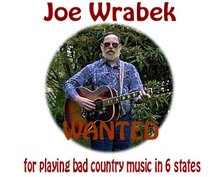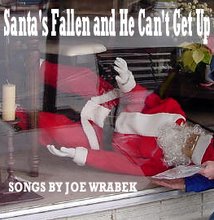RECORDING SONGS WITH A BAND: I have a couple of ways I can go, I think. I know a number of musicians within reasonable traveling distance—a couple of bass players, couple decent lead guitarists, couple of harmonica players, a female singer—and I could record their tracks one by one in person. I might even know a drummer—the pastor of one of our local churches, who showed up at one of the Friday Night Group sessions.
Alternatively, I can use people on line—probably different people, because the folks I’d record personally mostly don’t “do” Internet. (One of them doesn’t even own a computer.) If we were doing it on line, I’d send (or post somewhere) a “base” track, and have them e-mail me their contributions. That could be interesting, because I know some online musicians who play some really strange instruments.
And those aren’t mutually exclusive options, either. I could do a blend of both.
In both cases, I’d need to be mixing multiple tracks, and that probably means using the computer to do it—and that means learning to use Audacity, which thus far I’ve avoided doing. I did use Audacity experimentally to record the tracks for Beth Williams’ Hallowe’en song, “The Well in the Glade,” but I actually got better results just mixing it on the Tascam. (The one sound effect—called a “gloop”—I added in Audacity.)
PUBLISHING: Kristi Lee Cook, the Selma (OR) girl who became a several-weeks’ wonder in southern Oregon by becoming an American Idol finalist, has an album out; that sort of thing happens a lot with failed A.I. contestants. And the album is being pretty roundly panned by the critics—not because of Kristi’s singing (she is good), but because of the material (“it’s not her” and “standard Nashville drivel” were among the comments). It’s probably not surprising; the Really Famous People get to pluck the best of the output from the Music Machine, and the leavings just aren’t very good. (The “best” wasn’t very good to begin with.)
That underscores the need—expressed here earlier—for some sort of mechanism to connect regionally famous artists with material that isn’t part of the Music Machine. There is a market that is in need of good material, and there is good material (I heard a lot of it in southern Oregon) that isn’t getting to market. Why couldn’t (for example) Kristi, a very popular southern Oregon girl, put out an album of songs entirely written by people from southern Oregon? Songs that would not only fit her style, and convey the image she wants to project, and showcase her voice, but also would be better written songs than anything the Big Boys are offering? Wouldn’t an album like that sell?
One of the things a publisher does, I think, is contact the artist, and say, “Hey, I think I’ve got something; if you like it, have your record label call me and we can do a deal.” The publisher acts as the filter on the writer end, making sure the artist only gets material that has a good chance of being suitable; presumably, the artist also has a filter, in the form of an agent or manager—most regionally famous performers do, I think (the Dodson Drifters had an agent—he didn’t handle material, but if you wanted to talk to us, you had to go through the agent).
The point—reiterated before—is that the regionally famous folks may be easier to reach (if one can only figure out how), because their filters have less of an agenda of their own.
MARKETABILITY: Looking realistically, it’s the co-writes I’ve done with other folks, not the songs that are exclusively mine, that have the greatest potential for commercial success. These are the ones an outside artist—somebody who’s already sorta famous—would be likely to want to record.
Beth Williams’ “The Well in the Glade” is a bona fide new Hallowe’en song idea (and those are hard to come by); Donna Devine’s “Sometimes She Could Scream” tackles a serious social issue (in country music, of all things), Marge Mckinnis’ “So Far” and “About Love” are classic love songs (and “So Far” did make #28 in Goodnight Kiss’s contest this year—not high enough to get on the album, but hopefully high enough to get noticed). Rev. Skip Johnson’s hymn, “Tune the Striings of My Soul,” may appeal mostly to a Christian market, but the Christian music market is a big one. There are more. What can we do with those?
Joe
WELCOME...
This blog is the outgrowth of a songwriting workshop I conducted at the 2006 "Moograss" Bluegrass Festival in Tillamook, Oregon. It presumes that after 30-odd years of writing and playing music, I might have something to contribute that others might take advantage of. If not, it may be at least a record of an entertaining journey, and a list of mistakes others may be able to avoid repeating.
This blog is intended to be updated weekly. In addition to discussions about WRITING, it will discuss PROMOTION--perhaps the biggest challenge for a writer today--as well as provide UPDATES on continuing PROJECTS, dates and venues for CONCERTS as they happen, how and where to get THE LATEST CD, the LINKS to sites where LATEST SONGS are posted, and a way to E-MAIL ME if you've a mind to.
Not all these features will show up right away. Like songwriting itself, this is a work in progress. What isn't here now will be here eventually. Thank you for your interest and your support.
Subscribe to:
Post Comments (Atom)



No comments:
Post a Comment